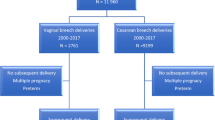Abstract
Objective
Primary aim of the study was to identify risk factors for an adverse neonatal outcome in emergency caesarean deliveries (ECD). Secondary, the influence of the decision-to-delivery interval (DDI) on neonatal outcome was evaluated.
Methods
Study period of this retrospective investigation was 2001–2011, in which 336 ECD were evaluated. Main outcome measures were risk factors associated with an adverse neonatal outcome (umbilical cord arterial pH < 7.05, umbilical cord arterial base excess (BE) < −12, Apgar score at 5 min <5 and the combination of umbilical cord arterial pH < 7.0, and umbilical cord arterial BE < −12). Secondary, the influence of the DDI on neonatal outcome was assessed. These parameters were tested in univariate and multivariate analyses.
Results
Prematurity (<37 + 0 weeks of gestation) and silent cardiotocography (CTG) were identified as the major risk factors for an adverse neonatal outcome. Statistical analyses of the influence of the DDI on umbilical cord arterial pH and BE as well as the Apgar score at 5 min revealed no significant results.
Conclusion
Our results emphasize the necessity of attendance in a level-3 department of obstetrics in case of conceivable compromised neonatal conditions. Prematurity and silent CTG were identified as the major risk factors for an adverse neonatal outcome. As long as the DDI is under 20 min, it did not have an impact on neonatal outcome.
Similar content being viewed by others
References
Royal College of Obstetricians and Gynaecologists (1995) Report of a joint working group: organisational standards for maternity services. RCOG Press, London
(1982) American College of Obstetricians and Gynecologists Committee on Professional Standards Standards for Obstetric-Gynecologic Services. American College of Obstetricians and Gynecologists, Washington DC
(1995) Stellungnahme der Deutschen Gesellschaft für Gynäkologie und Geburtshilfe Mindestanforderungen an prozessuale, strukturelle und organisatorische Voraussetzungen für geburtshilfliche Abteilungen.. Frauenarzt 36:27
Chauhan SP, Roach H, Naef RW 2nd, Magann EF, Morrison JC, Martin JN, Jr (1997) Cesarean section for suspected fetal distress. Does the decision-incision time make a difference? J Reprod Med 42(6):347–352
MacKenzie IZ, Cooke I (2001) Prospective 12 month study of 30 minute decision to delivery intervals for “emergency” caesarean section. BMJ 322(7298):1334–1335
Schauberger CW, Rooney BL, Beguin EA, Schaper AM, Spindler J (1994) Evaluating the thirty minute interval in emergency cesarean sections. J Am Coll Surg 179(2):151–155
Bloom SL, Leveno KJ, Spong CY, Gilbert S, Hauth JC, Landon MB et al (2006) Decision-to-incision times and maternal and infant outcomes. Obstet Gynecol 108(1):6–11
Hillemanns P, Strauss A, Hasbargen U, Schulze A, Genzel-Boroviczeny O, Weninger E et al (2005) Crash emergency cesarean section: decision-to-delivery interval under 30 min and its effect on Apgar and umbilical artery pH. Arch Gynecol Obstet 273(3):161–165
Ayres-de-Campos D, Bernardes J (2010) Twenty-five years after the FIGO guidelines for the use of fetal monitoring: time for a simplified approach? Int J Gynaecol Obstet 110(1):1–6
Gynecologists RCoOa (2007) NICE guideline on intrapartum care http://guidanceniceorguk/CG55
ACOG Committee Opinion (2005) Number 326, December 2005. Inappropriate use of the terms fetal distress and birth asphyxia. Obstet Gynecol 106(6):1469–1470
Robinson B, Nelson L (2008) a review of the proceedings from the 2008 NICHD workshop on standardized nomenclature for cardiotocography: update on definitions, interpretative systems with management strategies, and research priorities in relation to intrapartum electronic fetal monitoring. Rev Obstet Gynecol 1(4):186–192
Van Geijn HP (1996) Developments in CTG analysis. Baillieres Clin Obstet Gynaecol 10(2):185–209
Cabaniss DL, Roose SP (1993) Late onset tricyclic-induced agranulocytosis with an atypical course. Pharmacopsychiatry 26(4):130–131
Resnik R (2002) Intrauterine growth restriction. Obstet Gynecol 99(3):490–496
Cnattingius R, Hoglund B, Kieler H (2005) Emergency cesarean delivery in induction of labor: an evaluation of risk factors. Acta Obstet Gynecol Scand 84(5):456–462
Thorsell M, Lyrenas S, Andolf E, Kaijser M (2011) Induction of labor and the risk for emergency cesarean section in nulliparous and multiparous women. Acta Obstet Gynecol Scand 90(10):1094–1099
Buist R (1999) Induction of labour: indications and obstetric outcomes in a tertiary referral hospital. N Z Med J 112(1091):251–253
Maslow AS, Sweeny AL (2000) Elective induction of labor as a risk factor for cesarean delivery among low-risk women at term. Obstet Gynecol 95(6 Pt 1):917–922
Hannah ME, Hannah WJ, Hellmann J, Hewson S, Milner R, Willan A (1992) Induction of labor as compared with serial antenatal monitoring in post-term pregnancy. A randomized controlled trial. The Canadian Multicenter Post-term Pregnancy Trial Group. N Engl J Med 326(24):1587–1592
Caughey AB, Sundaram V, Kaimal AJ, Gienger A, Cheng YW, McDonald KM et al (2009) Systematic review: elective induction of labor versus expectant management of pregnancy. Ann Intern Med 151(4):252–263 W53-63
Ward CJ (1991) Analysis of 500 obstetric and gynecologic malpractice claims: causes and prevention. Am J Obstet Gynecol 165(2):298–304 (discussion-6)
Roemer VM, Heger-Romermann G (1993) Clinic structure and timely management of emergency cesarean section–reference values and recommendations. Z Geburtshilfe Perinatol 197(4):153–161
Spencer MK, MacLennan AH (2001) How long does it take to deliver a baby by emergency Caesarean section? Aust N Z J Obstet Gynaecol 41(1):7–11
Jibodu OA, Arulkumaran S (2000) Intrapartum fetal surveillance. Curr Opin Obstet Gynecol 12(2):123–127
MacKenzie IZ, Cooke I (2002) What is a reasonable time from decision-to-delivery by caesarean section? Evidence from 415 deliveries. BJOG 109(5):498–504
Conflict of interest
None.
Author information
Authors and Affiliations
Corresponding author
Rights and permissions
About this article
Cite this article
Berlit, S., Welzel, G., Tuschy, B. et al. Emergency caesarean section: risk factors for adverse neonatal outcome. Arch Gynecol Obstet 287, 901–905 (2013). https://doi.org/10.1007/s00404-012-2679-6
Received:
Accepted:
Published:
Issue Date:
DOI: https://doi.org/10.1007/s00404-012-2679-6



